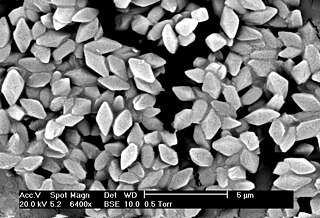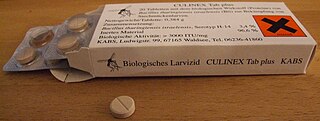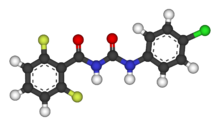
Bacillus thuringiensis is a gram-positive, soil-dwelling bacterium, the most commonly used biological pesticide worldwide. B. thuringiensis also occurs naturally in the gut of caterpillars of various types of moths and butterflies, as well on leaf surfaces, aquatic environments, animal feces, insect-rich environments, flour mills and grain-storage facilities. It has also been observed to parasitize moths such as Cadra calidella—in laboratory experiments working with C. calidella, many of the moths were diseased due to this parasite.

Insecticides are pesticides used to kill insects. They include ovicides and larvicides used against insect eggs and larvae, respectively. Acaricides, which kill mites and ticks, are not strictly insecticides, but are usually classified together with insecticides. The major use of Insecticides is agriculture, but they are also used in home and garden, industrial buildings, vector control and control of insect parasites of animals and humans. Insecticides are claimed to be a major factor behind the increase in the 20th-century's agricultural productivity. Nearly all insecticides have the potential to significantly alter ecosystems; many are toxic to humans and/or animals; some become concentrated as they spread along the food chain.

Cypermethrin (CP) is a synthetic pyrethroid used as an insecticide in large-scale commercial agricultural applications as well as in consumer products for domestic purposes. It behaves as a fast-acting neurotoxin in insects. It is easily degraded on soil and plants but can be effective for weeks when applied to indoor inert surfaces. It is a non-systemic and non-volatile insecticide that acts by contact and ingestion, used in agriculture and in pest control products. Exposure to sunlight, water and oxygen will accelerate its decomposition. Cypermethrin is highly toxic to fish, bees and aquatic insects, according to the National Pesticides Telecommunications Network (NPTN). It is found in many household ant and cockroach killers, including Raid, Ortho, Combat, ant chalk, and some products of Baygon in Southeast Asia.

Bifenthrin is a pyrethroid insecticide. It is widely used against ant infestations.

Imidacloprid is a systemic insecticide belonging to a class of chemicals called the neonicotinoids which act on the central nervous system of insects. The chemical works by interfering with the transmission of stimuli in the insect nervous system. Specifically, it causes a blockage of the nicotinergic neuronal pathway. By blocking nicotinic acetylcholine receptors, imidacloprid prevents acetylcholine from transmitting impulses between nerves, resulting in the insect's paralysis and eventual death. It is effective on contact and via stomach action. Because imidacloprid binds much more strongly to insect neuron receptors than to mammal neuron receptors, this insecticide is more toxic to insects than to mammals.

Neem oil, also known as margosa oil, is a vegetable oil pressed from the fruits and seeds of the neem, a tree which is indigenous to the Indian subcontinent and has been introduced to many other areas in the tropics. It is the most important of the commercially available products of neem, and its chemical properties have found widespread use as a pesticide in organic farming.

Fipronil is a broad-spectrum insecticide that belongs to the phenylpyrazole chemical family. Fipronil disrupts the insect central nervous system by blocking the ligand-gated ion channel of the GABAA receptor and glutamate-gated chloride (GluCl) channels. This causes hyperexcitation of contaminated insects' nerves and muscles. Fipronil's specificity towards insects is believed to be due to its greater binding affinity for the GABAA receptors of insects than to those of mammals, and for its action on GluCl channels, which do not exist in mammals. As of 2017, there does not appear to be significant resistance among fleas to fipronil.

Fenthion is an organothiophosphate insecticide, avicide, and acaricide. Like most other organophosphates, its mode of action is via cholinesterase inhibition. Due to its relatively low toxicity towards humans and mammals, fenthion is listed as moderately toxic compound in U.S. Environmental Protection Agency and World Health Organization toxicity class.

Fungus gnats are small, dark, short-lived gnats, of the families Sciaridae, Diadocidiidae, Ditomyiidae, Keroplatidae, Bolitophilidae, and Mycetophilidae ; they comprise six of the seven families placed in the superfamily Sciaroidea.
An entomopathogenic fungus is a fungus that can kill or seriously disable insects. They do not need to enter an insect's body through oral ingestion or intake; rather, they directly penetrate though the exoskeleton.

Mirex is an organochloride that was commercialized as an insecticide and later banned because of its impact on the environment. This white crystalline odorless solid is a derivative of cyclopentadiene. It was popularized to control fire ants but by virtue of its chemical robustness and lipophilicity it was recognized as a bioaccumulative pollutant. The spread of the red imported fire ant was encouraged by the use of mirex, which also kills native ants that are highly competitive with the fire ants. The United States Environmental Protection Agency prohibited its use in 1976. It is prohibited by the Stockholm Convention on Persistent Organic Pollutants.

Methoprene is a juvenile hormone (JH) analog which acts as a growth regulator when used as an insecticide. It is an amber-colored liquid with a faint fruity odor.

A larvicide is an insecticide that is specifically targeted against the larval life stage of an insect. Their most common use is against mosquitoes. Larvicides may be contact poisons, stomach poisons, growth regulators, or (increasingly) biological control agents.

Pyriproxyfen is a pesticide which is found to be effective against a variety of insects. It was introduced to the US in 1996, to protect cotton crops against whitefly. It has also been found useful for protecting other crops. It is also used as a prevention for flea control on household pets, for killing indoor and outdoor ants and roaches. Methods of application include aerosols, bait, carpet powders, foggers, shampoos and pet collars.

Benzoylureas (BPUs) are chemical derivatives of N-benzoyl-N′-phenylurea, which are used as insecticides. They do not directly kill the insect, but disrupt moulting and egg hatch, and thus act as insect growth regulators. They act by inhibiting chitin synthase, preventing the formation of chitin in the insect's body.

Spinosad is an insecticide based on chemical compounds found in the bacterial species Saccharopolyspora spinosa. The genus Saccharopolyspora was discovered in 1985 in isolates from crushed sugarcane. The bacteria produce yellowish-pink aerial hyphae, with bead-like chains of spores enclosed in a characteristic hairy sheath. This genus is defined as aerobic, Gram-positive, nonacid-fast actinomycetes with fragmenting substrate mycelium. S. spinosa was isolated from soil collected inside a nonoperational sugar mill rum still in the Virgin Islands. Spinosad is a mixture of chemical compounds in the spinosyn family that has a generalized structure consisting of a unique tetracyclic ring system attached to an amino sugar (D-forosamine) and a neutral sugar (tri-Ο-methyl-L-rhamnose). Spinosad is relatively nonpolar and not easily dissolved in water.

Hydramethylnon is an organofluorine compound. It is also known as AC 217,300. It is in a chemical class called trifluoromethyl aminohydrazone, which is a metabolic inhibitor. It is classified as a pesticide designed to control insects that are harmful to humans. It works by inhibiting complex III in the mitochondrial inner membrane and leads to a halting of oxidative phosphorylation. It is used primarily as an insecticide in the form of baits for cockroaches and ants. Some brands of insecticides that include hydramethylnon are Amdro, Blatex, Combat, Cyaforce, Cyclon, Faslane, Grant's, Impact, Matox, Maxforce, Pyramdron, Siege, Scuttle and Wipeout. Hydramethylnon is a slow-acting poison with delayed toxicity that needs to be eaten to be effective.

Acetamiprid is an organic compound with the chemical formula C10H11ClN4. It is an odorless neonicotinoid insecticide produced under the trade names Assail, and Chipco by Aventis CropSciences. It is systemic and intended to control sucking insects (Thysanoptera, Hemiptera, mainly aphids) on crops such as leafy vegetables, citrus fruits, pome fruits, grapes, cotton, cole crops, and ornamental plants. It is also a key pesticide in commercial cherry farming due to its effectiveness against the larvae of the cherry fruit fly.
An insect growth regulator (IGR) is a chemical insecticide that kills insects indirectly by disrupting their life cycles. The term was initially proposed to describe the effects of juvenile hormone analogs. Although the term "insect growth disruptor" more accurately describes the actions of IGRs, it did not become widely used. IGRs encompass chemical classes with three modes of action : juvenile hormone analogs, chitin synthesis inhibitors, and ecdysone receptor agonists.

Novaluron, or (±)-1-[3-chloro-4-(1,1,2-trifluoro-2-trifluoro- methoxyethoxy)phenyl]-3-(2,6-difluorobenzoyl)urea, is a chemical with pesticide properties, belonging to the class of insecticides called insect growth regulators. It is a benzoylphenyl urea developed by Makhteshim-Agan Industries Ltd.. In the United States, the compound has been used on food crops, including apples, potatoes, brassicas, ornamentals, and cotton. Patents and registrations have been approved or are ongoing in several other countries throughout Europe, Asia, Africa, South America, and Australia. The US Environmental Protection Agency and the Canadian Pest Management Regulatory Agency consider novaluron to pose low risk to the environment and non-target organisms and value it as an important option for integrated pest management that should decrease reliance on organophosphorus, carbamate and pyrethroid insecticides.



















